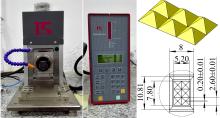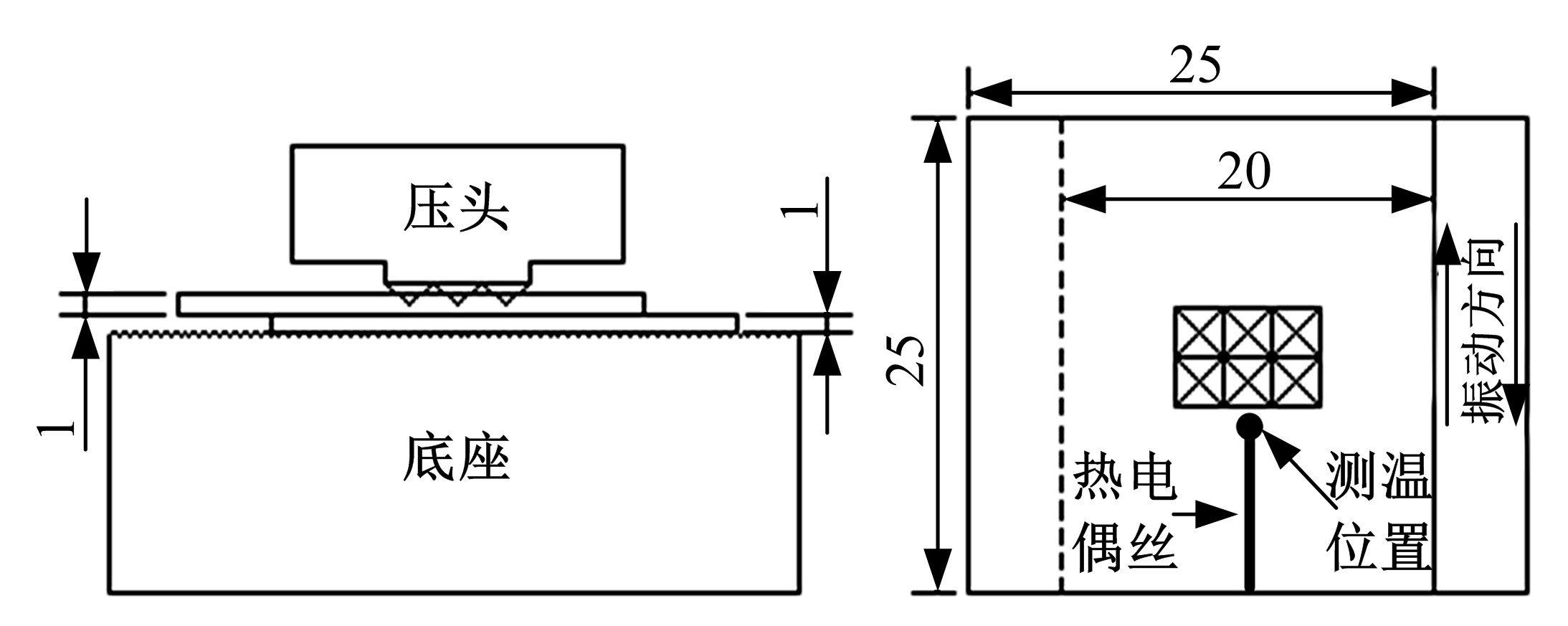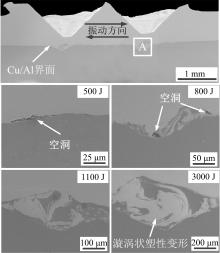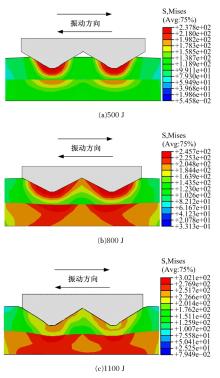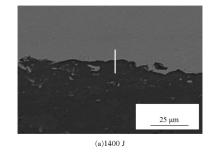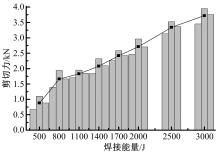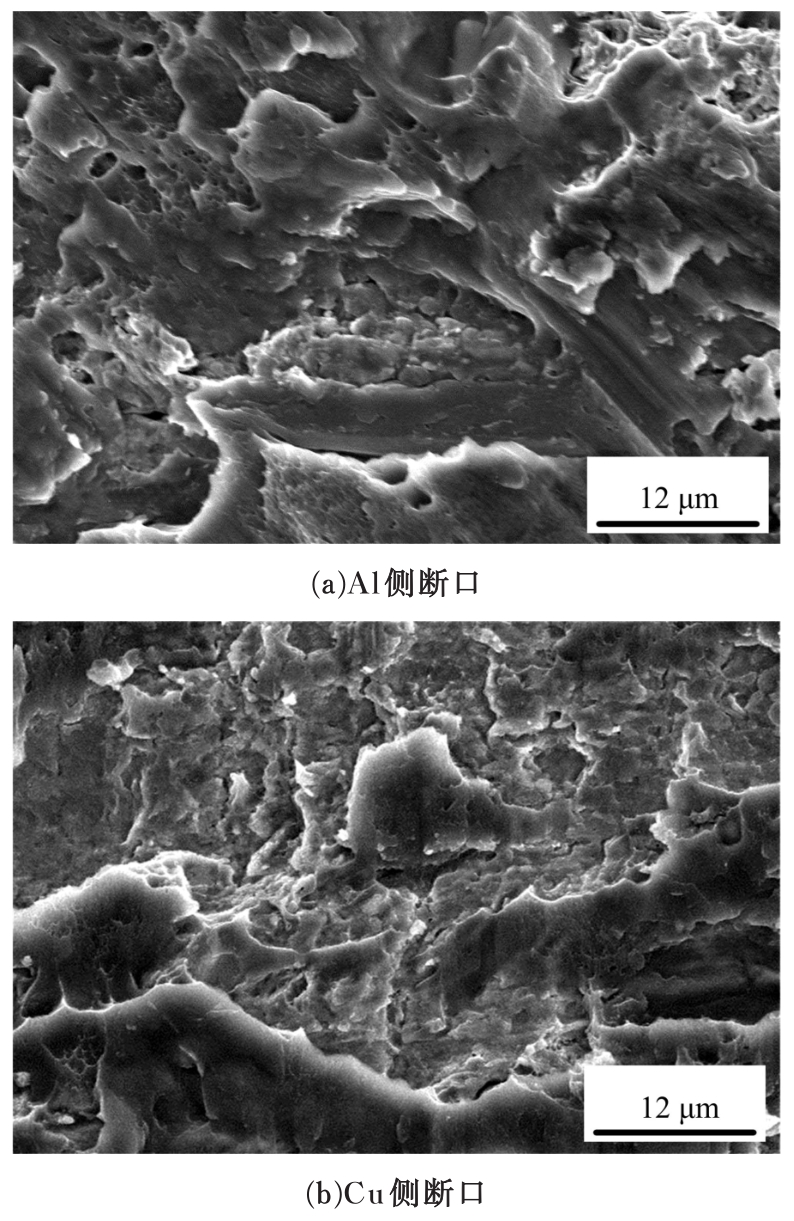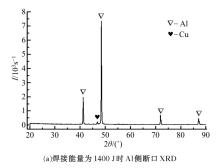Journal of Jilin University(Engineering and Technology Edition) ›› 2019, Vol. 49 ›› Issue (5): 1600-1607.doi: 10.13229/j.cnki.jdxbgxb20180340
Effect of welding energy on microstructure and mechanical properties of Cu/Al joints welded by ultrasonic welding
Xiao-yan GU1( ),Dong-feng LIU1,Jing LIU1,Da-qian SUN1,Hui-feng MA2
),Dong-feng LIU1,Jing LIU1,Da-qian SUN1,Hui-feng MA2
- 1. College of Materials Science and Engineering, Jilin University, Changchun 130022, China
2. Hebei YiBo Culture Development Co. , Ltd. , Shijiazhuang 050062, China
CLC Number:
- TG453.9
| 1 | 田尤, 杨为民, 申俊峰, 等. 中国铜资源产业形势分析及发展对策建议[J]. 资源与产业, 2015, 17(4): 100-105. |
| TianYou, YangWei-min, ShenJun-feng, et al. Analysis and recommendations of Chinese copper resources industry situation[J]. Resour & Industries, 2015, 17(4): 100-105. | |
| 2 | FeiXin-jiang, YeYing, JinLiang-liang, et al. Special welding parameters study on Cu/Al joint in laser-heated friction stir welding[J]. Journal of Materials Processing Technology, 2018, 256: 160-171. |
| 3 | HailatM M, MianA, ChaudhuryZ A, et al. Laser micro-welding of aluminum and copper with and without tin foil alloy[J]. Microsystem Technologies, 2012, 18(1): 103-112. |
| 4 | MatsuokaS, ImaiH. Direct welding of different metals used ultrasonic vibration[J]. Journal of Materials Processing Technology, 2009, 209(2): 954-960. |
| 5 | 夏春智, 李亚江, 王娟. Cu/Al异种金属连接的研究现状[J]. 焊接, 2008(1): 17-20. |
| XiaChun-zhi, LiYa-jiang, WangJuan. Research status of joining of Cu/Al dissimilar metals[J]. Welding & Joining, 2008(1): 17-20. | |
| 6 | KoyamaK, ShinozakiK, IkedaK, et al. Evaluation of brazing properties using Al-Si-Mg-Bi brazing alloy—Development of brazing technique for Al-Cu dissimilar joint (Part 1)[J]. Journal of Light Metal Welding & Construction, 2002, 40(9): 13-20. |
| 7 | MysI, SchmidtM. Laser micro welding of copper and aluminum[J]. Proceedings of SPIE—The International Society for Optical Engineering, 2006, 6107: 28-33. |
| 8 | LiH, CaoB, YangJ W, et al. Modeling of resistance heat assisted ultrasonic welding of Cu-Al joint[J]. Journal of Materials Processing Technology, 2018, 256: 121-130. |
| 9 | 左迪. 铜-铝异种金属激光焊接研究[D]. 天津: 天津大学材料科学与工程学院, 2014. |
| ZuoDi. Research on dissimilar material laser welding between Cu and Al[D]. Tianjing: School of Materials Science and Engineering, Tianjin University, 2014. | |
| 10 | ChenQ, LinS, YangC, et al. Grain fragmentation in ultrasonic-assisted TIG weld of pure aluminum[J]. Ultrasonics Sonochemistry, 2017, 39: 403-413. |
| 11 | SatoY S, UrataM, KokawaH. Parameters controlling microstructure and hardness during friction-stir welding of precipitation-hardenable aluminum alloy 6063[J]. Metallurgical & Materials Transactions A, 2002, 33(3): 625-635. |
| 12 | UeokaT, TsujinoJ. Welding characteristics of aluminum and copper plate specimens welded by a 19 kHz complex vibration ultrasonic seam welding system[J]. Japanese Journal of Applied Physics, 2002, 41(1): 32-37. |
| 13 | MatsuokaS, ImaiH. Direct welding of different metals used ultrasonic vibration[J]. Journal of Materials Processing Technology, 2009, 209(2): 954-960. |
| 14 | FloodG. Ultrasonic energy welds copper to aluminum[J]. Welding Journal, 1997, 76(1): 43-45. |
| 15 | PretoriusR, VredenbergA M, SarisF W, et al. Prediction of phase formation sequence and phase stability in binary metal-aluminium thin-film systems using the effective heat of formation[J]. Journal of Applied Physics, 1991, 70(7): 3636-3646. |
| 16 | BraunovicM, AleksandrovN. Effect of electrical current on the morphology and kinetics of formation of intermetallic phases in bimetallic aluminum-copper joints[C]∥IEEE Holm Conference on Electrical Contacts, Pittsburgh, PA, 1993: 261-268. |
| [1] | Zhuo YI,Wen-zhi FU,Ming-zhe LI. Numerical simulation and experiment on double⁃layered split ultrahigh pressure die [J]. Journal of Jilin University(Engineering and Technology Edition), 2019, 49(5): 1593-1599. |
| [2] | Xue⁃guang ZHANG,Ming⁃meng JIA,Chun⁃guo LIU,Guang⁃zhong HE. Trajectory design and FE simulation for profile stretch bending based on incremental control method [J]. Journal of Jilin University(Engineering and Technology Edition), 2019, 49(4): 1272-1279. |
| [3] | DAI Yan, NIE Shao-feng, ZHOU Tian-hua. Finite element analysis of hysteretic behavior of square steel tube confined steel reinforced concrete column steel frame ring beam joint [J]. Journal of Jilin University(Engineering and Technology Edition), 2018, 48(5): 1426-1435. |
| [4] | WANG Hui, ZHOU Jie, XIONG Yu, TAO Ya-ping, XIANG Rong. Springback compensation for stamping part with complex surface based on reverse engineering [J]. 吉林大学学报(工学版), 2017, 47(6): 1842-1847. |
| [5] | WANG Chun-sheng, ZOU Li, YANG Xin-hua. Analysis of fatigue life factors of aluminum alloy welded joints based on neighborhood rough set theory [J]. 吉林大学学报(工学版), 2017, 47(6): 1848-1853. |
| [6] | YIN Zi-hong, ZHU Bo, SHAO Guo-xia, KONG De-hui, JIANG Liang-wei. Response of railway track and subgrade under the effect overweight goods [J]. 吉林大学学报(工学版), 2017, 47(5): 1446-1452. |
| [7] | LUN Feng-yan, FU Wen-zhi, LI Ming-zhe, YI Zhuo, WANG Xin-tong, CHEN Xue. Forming of flexible rolling of three-dimensional surface based on bended rolls [J]. 吉林大学学报(工学版), 2017, 47(3): 876-883. |
| [8] | HU Kan, YU Ye, YING Liang, HU Ping, HOU Wen-bin. Optimization design of hot-stamping beam structure considering rollover crash safety of school bus [J]. 吉林大学学报(工学版), 2017, 47(3): 884-890. |
| [9] | LAN Feng-chong, LI Zhong-chao, ZHOU Yun-jiao, CHEN Ji-qing. Stress distribution and strength prediction of aluminum-magnesium alloy adhesive-bonded single-lap joints [J]. 吉林大学学报(工学版), 2015, 45(3): 726-732. |
| [10] | HU Zhi-qing,ZHEN Jiao-jiao,FENG Zeng-ming,ZHOU Shu-hong. Flexible rolling and stretch forming surface technology and numerical simulation [J]. 吉林大学学报(工学版), 2014, 44(3): 701-707. |
| [11] | WANG Mi, CAI Zhong-yi, LI Ming-zhe, WANG Da-ming. Calculation of bending deformation of flexible roll forming for three-dimensional surface parts and numerical simulation [J]. 吉林大学学报(工学版), 2014, 44(2): 404-408. |
| [12] | LI Ren-jun, LI Ming-zhe, XUE Peng-fei, CAI Zhong-yi, QIU Ning-jia. Method of flexible rolling for surface sheet metal [J]. 吉林大学学报(工学版), 2013, 43(06): 1529-1535. |
| [13] | CAO Jun-hui, FU Wen-zhi, LI Ming-zhe, PENG He-li. Influence factors on dimpling in multi-point thermoforming for polymer sheet [J]. 吉林大学学报(工学版), 2013, 43(06): 1536-1540. |
| [14] | ZHANG Lin, ZHAO Hong-wei, YANG Yi-han, MA Zhi-chao, HUANG Hu, MA Zhi-chao. Molecular dynamics simulation of nanoindentation of single-layer graphene sheet [J]. 吉林大学学报(工学版), 2013, 43(06): 1558-1565. |
| [15] | SUI Zhou, CAI Zhong-yi, LAN Ying-wu, LI Ming-zhe. Shape control model for three-dimensional surface part in continuous flexible forming process [J]. 吉林大学学报(工学版), 2013, 43(05): 1302-1306. |
|
||
